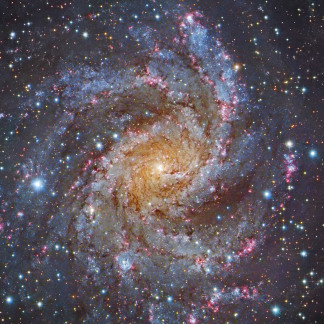The first words found in the Bible introduce us to the Creator of all things through astronomy when it states, "In the beginning God created the heavens and the earth." (Genesis 1:1, HBFV). They boldly declare that sometime in the distant past an all-powerful Being created all the astronomical objects we view at night. This article will briefly review a few references to astronomy found in God's word.
Astronomy, in general, is the study of celestial bodies and the universe as a whole. It includes the study of stars, planets, galaxies and other objects that are beyond the atmosphere of earth. God's word does reference several objects, such as planets and constellations, found in what we today call space.
For example, the most studied star in astronomy, the sun, is mentioned at least 160 times in the King James Bible, with the moon referred to 51 times. During Biblical times, the only planets viewable from the earth were Mercury, Venus, Mars, Jupiter and Saturn. Some of these can be found in Scripture but only by the false gods which were associated with them.

The Brightest Object
The planet Venus is the brightest object (next to the sun and moon) we can see in the night sky. Its ability to reflect light is due to its close proximity to the sun and the highly reflective clouds of sulfuric acid that shroud it. Many times it can easily be seen just before sunrise, hence its reference in astronomy as the "morning star." It can even be viewed during the day, lending to it also being called the "day star."
There are allusions in Scripture to Christ being the morning star. Since Venus was the brightest of all the points of light in the sky the analogy would be that Christ would be the brightest (or have the preeminence) over the other heavenly bodies, which are the stars that correspond to angels (2Peter 1:19, Revelation 2:26, 28, 22:16).
Old and New Testament Saturn
Stephen, in his final words before his death, makes a rather odd and obscure astronomical reference.
Yea, ye took up the tabernacle of Moloch, and the star of your god Remphan (Strong's #G4481), figures which ye made to worship them: and I will carry you away beyond Babylon (Acts 7:43, KJV).
The word Remphan used in Stephen's discourse above is derived from the Greek Rhemphan. According to Strong's Concordance, this word is an erroneous transliteration of the Hebrew word kiyun or Chiun (Strong's #H3594). The only place in the entire Old Testament where kiyun is found is in Amos 5.
But ye have borne the tabernacle of your Moloch and Chiun (kiyun) your images, the star of your god, which ye made to yourselves (Amos 5:26, KJV).
According to a 1913 Catholic Encyclopedia article on Astronomy, the planet Saturn is directly referenced in the book of Amos.
"Saturn is no less certainly represented by the star Kaiwan (called "Chiun" in the King James Translation), adored by the reprobate Israelites in the desert (Amos 5:26)."
One of Ancient Israel's chief sins was idolatry. It was common in Israel's history, especially after the united kingdom split in 930 B.C., to worship pagan deities. Among the false worship adopted by the people was the worship of the hosts of heaven, meaning the sun, moon, planets and stars. Many Biblical commentaries believe that Amos' reference to Chiun, labeled Remphan in Acts 7:43, is another name for the planet Saturn.
A 1906 Jewish Encyclopedia article on astronomy also offers hints where Saturn might be referenced in the Old Testament.
"At the head of this starry host stands a "captain of the army" (Joshua 5:14, Daniel 8:11); according to the passage in Daniel, he was the star highest in altitude as well. By this designation probably Saturn was intended, the farthest removed from earth and therefore the highest in the heavens . . ."
Allusions to Jupiter, Venus
Isaiah 65 in the Bible contains, according to the Jamieson-Fausset-Brown Commentary, allusions to astronomy in its reference to Jupiter and Venus.
But you who forsake the Lord, who forget My holy mountain, who prepare a table for Fortune (gad, Strong's #H1409), and who furnish the drink offering to Fate (meniy, Strong's #H4507) (Isaiah 65:11, HBFV).
The Hebrew word gad in Isaiah 65:11 is an astronomical reference to the Babylonian god linked to Jupiter. The Hebrew word meniy is linked to the planet Venus.
Constellations
Scripture also contains several other astronomy related references to constellations or groupings of stars. The book of Job mentions space related phenomena more than any other book. Constellations such as the Bear (Arcturus), Orion, and Pleiades are written about in Job 9 and Amos 5.
He alone stretches out the heavens, and walks on the waves of the sea; Who made the Bear, Orion, and Pleiades, and the chambers of the south; Who is doing great things past finding out; yea, marvelous things without number? (Job 9:8 - 10, see also 38:31 - 33).
Seek Him Who created the Pleiades and Orion, and Who turned the deep darkness into the morning, and Him Who darkened the day into night. Seek Him Who calls for the waters of the sea, and pours them out on the face of the earth - the Lord is His name (Amos 5:8, HBFV).
Modern astronomy informs us that the number of stars in the observable universe (all objects whose light and other signals can reach the earth) is 300 sextillion (that's 3 followed by 23 zeros)! A 2016 study, published in "The Astrophysical Journal," estimated that, at a minimum, 2 trillion galaxies exist in the observable universe.
Given all of the above, it should therefore not be surprising that God, who created everything we find in space, mentions some of them in the Bible. He has graciously allowed us, through astronomy, to witness his handiwork and the power he lovingly wields.